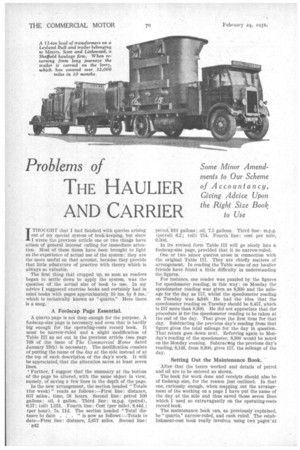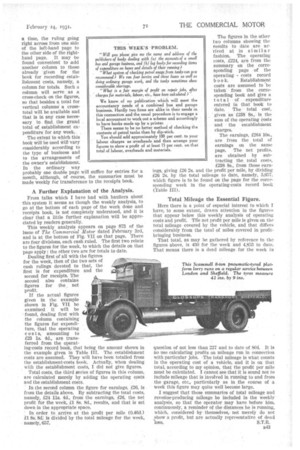Problems of
Page 76

Page 77

If you've noticed an error in this article please click here to report it so we can fix it.
THE HAULIER
AND CARRIER
Some Minor Amendments to Our Scheme of Accountancy, Giving Advice Upon the Right Size Book to Use
ITHOUGHT that I had finished with queries arising out of my special system of book-keeping, but since I wrote the previous article one or two things have arisen of general interest calling for immediate attention. Most of these items have been brought to light as the experience of actual use of the system: they are the more useful on that account, because they provide that little admixture of practice with theory which is alvirayS so valuable.
The first thing that cropped up, so soon as readers began to 'settle down to apply the system, was the question of the actual size of book to use. In my advice I suggested exercise books and certainly had in mind books with pages approximately 10 ins. by 8 iris., which is technically known as "quarto." Here there is a snag.
A Foolscap Page Essential.
A quarto page is not deep enough for the purpose. A foolscap-size page is necessary and even that is hardly big enough for the operating-costs record book. It must be narrow-ruled and a slight modification of Table HI as set out in the previous article (see page 768 of the issue of The Commercial Motor dated January 13th) is necessary. The modification consists of putting the name of the day at the side instead of at the top of each description of the day's work. It will be appreciated, that the alteration saves at least seven lines.
• Further, I suggest that the summary at the bottom of the page be altered, with the same object in view, namely, of saving a few lines in the depth of the page. In the new arrangement, the section headed "Totals (for week) " reads as follows :—First line; distance, 057 miles. time, 58 hours. Second line: petrol 100
gallons; oil, # gallon. Third : m.p.g. (petrol), 6.57; (oil) 1,051. Fourth line: Cost (per mile), 8.44t; (per hour), 7s. lid. The section headed "Total distance to date . : . "is now as follows :—Totals to date—First line : distance, 5,657 miles. Second line:
'B42 petrol, 910 gallons ; oil, 7.5 gallons. Third line : m.p.g. (petrol) 6.2; (oil) 754. Fourth line : cost per mile, 9.50d.
In its revised form Table .III will go nicely into a foolscap-size page, provided that it be narrow-ruled.
One or two minor queries arose in connection with the original Table III. They are chiefly matters of arrangement. In reading the Table some of my haulier friends have found a little difficulty in understanding the figures.
For instance, one reader was puzzled by the figures for speedometer reading, in this way: on Monday the speedometer reading was given as 8,300 and the mileage for the day as 157, whilst the speedometer reading on Tuesday was 87348. He had the idea that the speedometer reading on Tuesday should be 8,457, which is 157 more than 8,300. He did not appreciate that the procedure is for the speedometer reading to be taken at the end of the day. That gives the first item for that day. Subtracting the previous day's reading from that figure gives the total mileage for the day in question. That return goes down next. Referring again to Monday's reading of the speedometer, 8,300 would be noted on the Monday evening. Subtracng the previous day's reading, 8,143, from 8,300, gives 157, the mileage of the day.
Setting Out the Maintenance Book.
After that the hours worked and details of petrol and oil are to be entered as shown.
The book for work done and receipts should also be of foolscap size, for the reason just outlined. In that one, curiously enough, when mapping out the arrangement of the working on a page I have put the name of the day at the side and thus saved those seven lines which I used so extravagantly on the operating-costs record book.
The maintenance book can, as previously 'explained, be "quarto," narrow-ruled, and cash ruled. The establishment-cost book really involves using two" page Sat a time, the ruling going right across from one side of the left-hand page to the other side of the righthand page. It may be found convenient to add another column to those already given for the book for recording establishment costs, namely, a column for totals. Such a column will serve as a cross-check• on the figures, so that besides a total for vertical columnsa crosstotal will be available and that is in any case necessary to find, the grand total of establishment expenditure for any week.
The extent to which this book Will be used will 'vary considerably according to the type of business and to the arrangements of the owner's establishment. In the ordinary way probably one double page will suffice for entries for a month, although, of course, the summaries must be made weekly for transference to the receipts book.
A Further Explanation of the Analysis. From talks which I have had with hauliers about this system it seems as though the weekly analysis, to go at the bottom of each page of the work done and receipts book, is not completely understood, and it is clear that a little further explanation will be appreciated by readers generally.
This weekly analysis appears on page 873 of the issue of The Commercial Motor dated February 3rd, and is at the bottom of Fig. VII on that page. There are four divisions, each cash ruled. The first two relate to the figures for the week, to which the details on that page apply : the other two are for totals to date.
Dealing first of all with the figures for the week, then of the two sets of cash rulings devoted to that, the first is for expenditure and the second for receipts. The second also contains figures for the net profit.
If the actual figures given in the example shown in Fig. VII be examined it will be found, dealing first with the column containing the figures for expenditure, that the operating cost s, amounting to £23 is. 4d., are transferred from the operating-costs record book, that being the amount shown in the example given in Table III. The establishment costs are assumed. They will have been totalled from the establishment-costs book. Actually, when dealing with the establishment costs, I did not give figures.
Total costs, the third series of figures in this column, are calculated merely by adding the operating costs and the establishment costs.
In the second column the figure for earnings, £26, is from the details above. BY subtracting the total costs, namely, £24 us. 4d., from the earnings, £26, the net profit for the week, D. 8s. 8d., results, and that is set down in the appropriate space.
' In order to arrive at the profit per mile (0.46d.) b. 8s. 86: is divided by the total mileage for the week, namely, 657. The figures in the other two columns showing the results to date are arrived at in similar fashion. The operating costs, 1224, are from the summary on the corresponding page of the operating costs record b 0° k. Establishment costs are assumed to be taken from the corresponding book and give a total of expenditure entered in that book to date. The total cost, given as £238 8s., is the sum of the operating Costs and the establishment charges.
The earnings, £264 10s., are from the total of earnings on the same page. The net profits, are obtained by subtracting the total costs, £238 8s., from those earn ings, giving £26 2s. and the profit per mile, by dividing £26 2s. by the total mileage to date, namely, 5,657. which figure is to be found on the page for the corresponding week in the operating-costs record book (Table III).
Total Mileage the Essential Figure.
Here there is a point of especial interest to which I have, to some extent, drawn attention in the figures that appear below this weekly analysis of operating costs and profit. Tlle net profit per mile is given on the total mileage covered by the vehicle, and that differs considerably from the total of miles covered in profitbringing business.
That total, as may be gathered by reference to the figures above, is 430 for the week and 4,853 to date. That means there is a dead mileage for the week in question of not less thart 227 and to date of 804. It is no use calculating profits on mileage run in connection with particular jobs. The total mileage is what counts in the operating cost of a vehicle, and it is on that total, according to my opinion, that the profit per mile must be calculated. I cannot see that it is sound not to include mileage that is involved hi running to and from the garage, etc., particularly as in the course of a week this figure may quite well become large.
I suggest that these summaries of total mileage and revenue-producing mileage be included in the weekly analysis, so that the operator may have before him, continuously, a reminder of the distances he is running, which, considered by themselves,not merely do not show a profit, but are actually representative, of dead loss. S.T.R.




















































































































